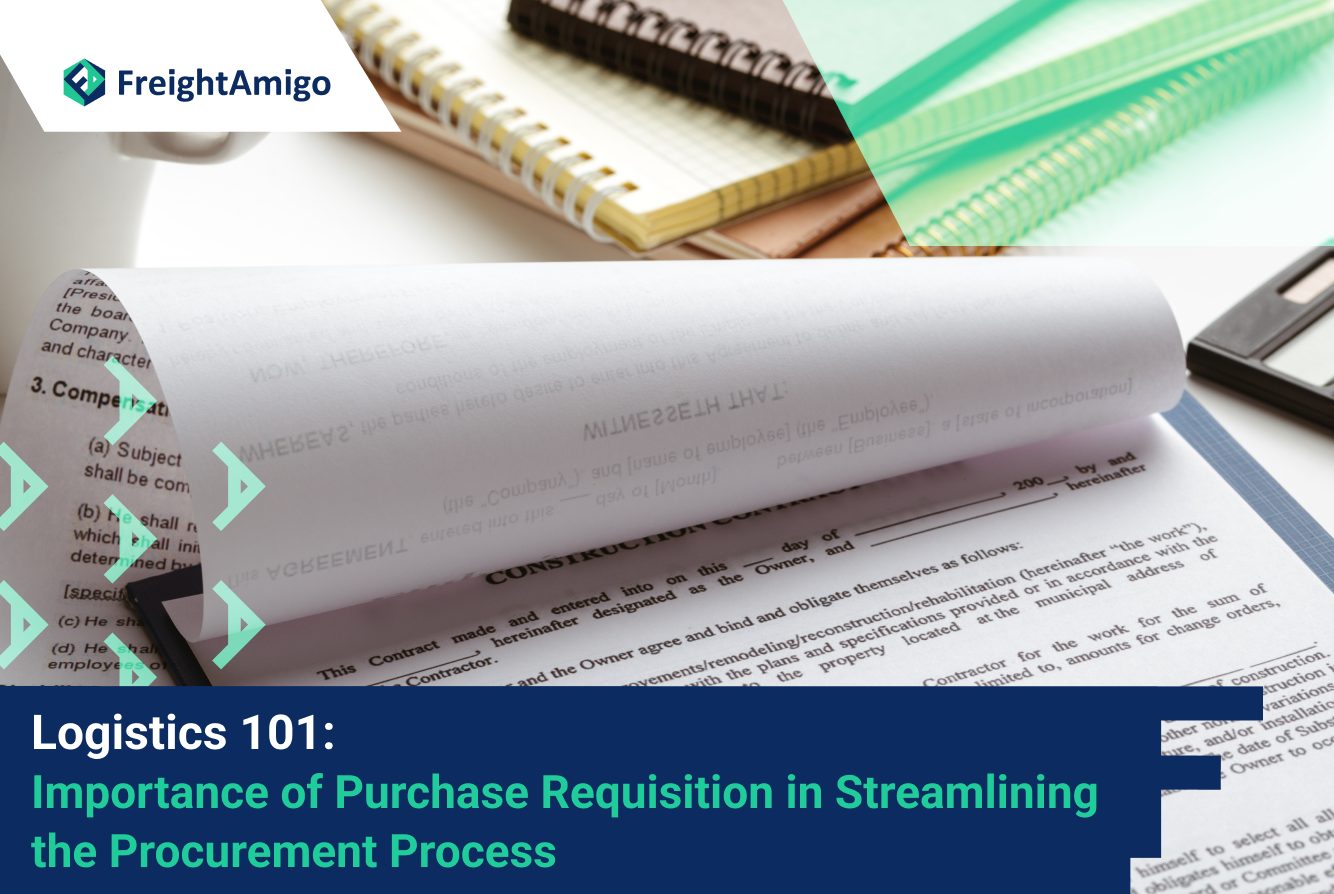In any business, the procurement process plays a crucial role in ensuring the smooth operation of various departments. From office supplies to raw materials and equipment, multiple departments require goods and services on a regular basis. However, without proper protocols and controls in place, the purchasing process can lead to increased expenses, expense fraud, and budgetary issues. To mitigate these risks, many companies have implemented a streamlined purchasing process with well-defined approval workflows, starting with a document called a purchase requisition form.
Author Name: Tiffany Lee – Marketing Analyst at FreightAmigo
Want to compare the best Express, Air Freight, Sea Freight, Rail Freight & Trucking rates so as to have better control on cost?
What is a Purchase Requisition Form?
A purchase requisition form is an internal document used by employees to request the purchase of goods or services on behalf of their firm. It serves as the first step in creating an effective audit trail for purchasing and is submitted to the purchasing department for approval. Once approved, a purchase order is issued to the vendor, making the purchase a legally binding contract.
Contents of a Purchase Requisition Form
A purchase requisition form typically includes the following information:
- Name and department of the requestor
- Date of the request
- Products or services requested
- Item description, quantity, and price
- Reason for purchase
- Legal name of the supplier
Steps Involved in the Purchase Requisition Workflow
The steps in a purchase requisition workflow may vary from one company to another. However, the basic outline of the process remains the same. Let’s explore each step in more detail:
-
Submission of Purchase Requisition Form
An employee recognizes the need for goods or services and fills out a purchase requisition form with the details of the desired purchase. This form can be filled out manually or through spend management software, depending on the company’s processes.
-
Approval from the Line Manager
The purchase requisition form is then subjected to an internal approval process, where it is verified by the line manager of the requestor’s department. The line manager ensures the legitimacy of the purchase and checks that the value of the purchase does not exceed the department’s allotted spending limit.
-
Stocktaking by Inventory Department
Next, the requisition form is routed to the inventory department, which checks it against the company’s existing stock. If the requested materials are not already in stock, the inventory department forwards the request to the purchasing department.
-
Screening by Purchasing Department
In the purchasing department, the request is processed by the appropriate officer, typically the purchasing manager. The officer identifies the business need for the products/services, checks the legitimacy of the purchase, and confirms that the requisition is duly signed and authorized. If any vital details are missing, the officer may either fill them in or send the form back to the requestor for completion. If the request appears inappropriate or exceeds the applicable purchasing limits, the purchase requisition form is rejected and sent back to the requestor with comments justifying the rejection.
-
Generating a Purchase Order
If the purchase requisition form receives all necessary approvals, a purchase order is generated and sent to the vendor. Once the vendor accepts the purchase order, the purchase becomes a legally binding contract.
-
Order Delivery and Assessment
When the products or services are delivered by the vendor, the receiving department checks the order for quality and quantity. A three-way matching process is carried out, which involves comparing the purchase order, order receipt/packaging slip, and invoice to ensure the accuracy of the order. This step ensures that the finance or accounting team pays only for the items they have ordered and received, preventing any overpayments. If any returns are required, they are processed by the warehouse or receiving team.
-
Invoice Payment
Once all documentation requirements are met, the purchase order is closed. The vendor’s invoice is approved by the finance team, entered into the accounts payable, and paid according to the payment terms and conditions.
Benefits of Implementing Purchase Requisition in the Procurement Process
Enforcing the use of purchase requisition forms in the procurement process offers several benefits to businesses. Let’s explore these benefits in more detail:
-
Transparency in the Procurement Process
The steps involved in the purchase requisition workflow add levels of hierarchical approval, ensuring that the document is checked for accuracy and legitimacy. This workflow provides evidence of a form being issued and submitted by a department, confirming that the requestor had a legitimate business purpose for the supplies. Purchase requisition forms often include the applicable budget and purchase limits, informing the requestor before a purchase is made. This ensures that products and services are purchased with the consent of the line manager and that sufficient funds are available.
-
Streamlined Purchasing Process
Centralizing the purchasing process and getting employees on board with using purchase requisition forms result in a well-defined and easy-to-manage workflow. It simplifies the organization and identification of incoming products and services and streamlines inventory management. Ultimately, a centralized purchase system accelerates the purchasing process and reduces delays caused by individual departments, enhancing overall efficiency.
-
Fraud Prevention
The absence of well-defined protocols leaves room for employees to engage in fraudulent acts such as ordering materials for personal use or colluding with vendors to steal from the firm. Purchase requisition forms deter fraud by ensuring that staff cannot order goods directly from vendors without following a formal process. The approval workflow and documentation trail provide transparency, making it easier to detect and prevent fraudulent activities.
-
Avoidance of Duplicate Orders
In large companies where multiple employees are involved in purchasing, purchase requisition forms help the purchasing department keep track of requests and avoid accidentally making duplicate purchases for the same order. This prevents unnecessary expenses and ensures efficient use of company resources.
-
Increased Accountability and Business Security
Purchase requisition forms serve as proof that certain materials were needed by a department and that they were ordered. Upon receiving the materials, the requisition forms create a document trail to show that the items were delivered. This record can be used as backup evidence in case of any later issues regarding the items ordered or the negotiated price. It increases accountability and strengthens the security of the business by providing a documented record of the purchasing decisions made.
-
Cost Savings
By establishing a single platform to manage purchase requests, businesses can save money and time. Aggregating purchases allows for a comprehensive view of the buying patterns, which enables businesses to negotiate with vendors for preferred pricing. This consolidated approach to purchasing helps identify cost-saving opportunities and optimize procurement spend.
-
Proof during Audits
Purchase requisition forms play a crucial role during audits as they provide evidence of approval from managers for the company’s purchasing decisions. These forms contain all the necessary details, such as the requestor’s information, approval timestamps, and the approved materials, making them perfect evidence for audits.
Integrating FreightAmigo with Your Purchase Requisition System
Integrating FreightAmigo with your purchase requisition system allows for seamless connectivity between procurement and logistics. By linking the two, you can match transportation requirements with purchase requisitions, estimate transportation costs, and foster logistics coordination. This integration streamlines the procurement process, ensures alignment between logistics and purchasing needs, and optimizes supply chain operations.
While the purchase requisition form may seem like just another form to fill out, it plays an important role in streamlining the procurement process. It provides internal control over purchasing, prevents fraud, creates an audit trail, and helps make the purchasing process transparent and efficient. By enforcing the use of purchase requisition forms and integrating them with other systems like FreightAmigo, businesses can enhance the overall efficiency of their procurement processes and optimize supply chain operations.
There are different options for cargo transportation. If you want to choose the most convenient and suitable solution, it is best to have the full support of logistics experts! If you are planning to ship goods overseas, please go to the FreightAmigo page for inquiries.
===
If you have any inquiries on logistics/supply chain, feel free to contact FreightAmigo now:
Chat with us online OR
Phone : +852 28121686
WhatsApp: +852 27467829









































